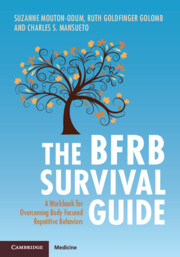Refine search
Actions for selected content:
5 results
1 - Getting Started on Your BFRB Journey
- from Part I - Preparation, Gaining Perspective, and Heightening Awareness of Your BFRB
-
- Book:
- The BFRB Survival Guide
- Published online:
- 26 May 2025
- Print publication:
- 12 June 2025, pp 3-35
-
- Chapter
- Export citation

The BFRB Survival Guide
- A Workbook for Overcoming Body Focused Repetitive Behaviors
-
- Published online:
- 26 May 2025
- Print publication:
- 12 June 2025
Prevalence of body-focused repetitive behaviors in a diverse population sample – rates across age, gender, race and education
-
- Journal:
- Psychological Medicine / Volume 54 / Issue 8 / June 2024
- Published online by Cambridge University Press:
- 13 December 2023, pp. 1552-1558
-
- Article
- Export citation
23 - Pyromania: Clinical Aspects
- from Section IV - Sexual and Aggressive Impulses
-
-
- Book:
- Impulse Control Disorders
- Published online:
- 06 July 2010
- Print publication:
- 08 February 2010, pp 255-268
-
- Chapter
- Export citation
22 - Intimate Partner Violence: Aggression at Close Quarters
- from Section IV - Sexual and Aggressive Impulses
-
-
- Book:
- Impulse Control Disorders
- Published online:
- 06 July 2010
- Print publication:
- 08 February 2010, pp 240-254
-
- Chapter
- Export citation
